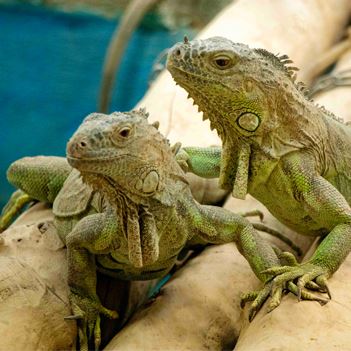Names
ایگوانا :Persian Name
إغوانا :Arabic Name
English Name: Iguana
Scientific Name: Iguana
General Classification
Kingdom: Animalia
Phylum: Chordata
Class: Reptilia
Order: Squamata
Family: Iguanidae
Habitat
Iguanas are typically found in tropical and subtropical regions of the Americas, from southern Mexico and the Caribbean to Paraguay and Brazil. They primarily inhabit tropical rainforests, often near water bodies and rivers, or in drier habitats but with access to dense vegetation. Iguanas are largely arboreal, spending most of their time in trees
Conservation Status
Some iguana species, such as the Green Iguana, are listed as “Least Concern” by the IUCN. However, other species, particularly those endemic to islands, are categorized as Vulnerable, Endangered, or even Critically Endangered due to habitat loss, invasive species, and hunting.
Diet
Iguanas are primarily herbivorous, feeding on leaves, flowers, and fruits from trees and plants. They have a diverse diet and may, in rare instances, consume small insects or arthropods, especially when young
Threatening Factors
The most significant threats to iguanas include habitat destruction and loss due to urbanization, agriculture, and deforestation; hunting by humans for the pet trade and meat consumption; and competition or predation by invasive species like cats and dogs
Gestation Period
The gestation period (from egg laying to hatching) for iguanas is approximately 65 to 75 days
Number of Offspring
The number of eggs laid in a single clutch typically ranges from 20 to 70 eggs
Age of Maturity
Iguanas reach sexual maturity at around 2 to 4 years of age
Lifespan
The lifespan of iguanas in the wild is about 8 years, and in captivity, they can live up to 20 years or more
Body Length
The body length of iguanas (from head to tail tip) can reach 1.5 to 2 meters
Height
Iguanas do not have a distinct height due to their short legs and flattened bodies; when crawling on the ground, they are less than 30 cm tall
Body Weight
The body weight of iguanas (depending on species and age) can vary from 1 to 8 kilograms
Interesting Facts
Iguanas have the ability to change their skin color to regulate body temperature and communicate with their surroundings. They can detach their tails when threatened to escape from predators
Introduction
Iguanas are fascinating and large reptiles primarily residing in the warm, tropical regions of the Americas, renowned for their distinctive appearance and diverse colorations. These animals are predominantly arboreal, spending their lives atop tree branches, where they are both safe from predators and have access to their plant-based food sources. They play a crucial role as primary consumers in forest ecosystems
These calm yet agile reptiles, with their keen eyesight and excellent vision, can easily monitor their surroundings. Unique abilities such as changing skin color for camouflage or temperature regulation, as well as the capacity to shed their tails in emergencies, have made them highly adaptable creatures. Unfortunately, some species face significant population declines due to human activities
Protecting the natural habitats of iguanas and preventing the illegal trade of these animals are among the most important measures undertaken to conserve these valuable species. A deeper understanding of their behavior and biological needs can contribute to more effective planning for their long-term survival, ensuring their role in maintaining natural balance

